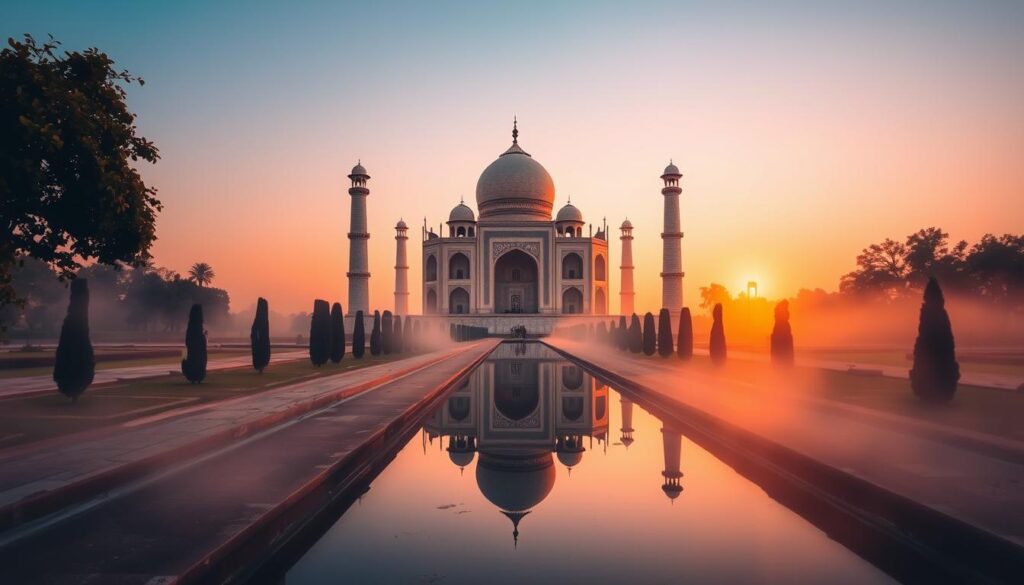
As I walked through Agra’s busy streets, the smell of spices filled the air. The sound of rickshaws added to the excitement. I was about to see the Taj Mahal, a wonder of the world. Its white marble and detailed design had always fascinated me.
I wondered when was the best time to see the Taj Mahal. Would the morning light or sunset colors look best? Would I have to fight through crowds or find a quiet spot? These thoughts ran through my mind as I entered the Taj Mahal. I was ready to explore and find the perfect time to visit.
Key Takeaways
- The best time to visit the Taj Mahal is during the cooler months of October to March, when the weather is pleasant and crowds are manageable.
- Weekdays typically have fewer visitors compared to weekends and public holidays, allowing for a more serene experience.
- Night viewing tours of the Taj Mahal are available on select nights around the full moon, providing a unique and romantic perspective.
- Advance reservations are required for night viewing tours due to limited availability.
- The Taj Mahal is open from sunrise to sunset, with slight variations depending on the season.
My Unforgettable Experience at the Taj Mahal
As I approached the Taj Mahal, its massive size took my breath away. My first view of it was from the Agra Fort. It stood tall, drawing my attention and awe. I knew I had to see it for myself.
First Glimpse of the Taj Mahal
Walking through the East Gate, I felt a mix of disbelief and wonder. Seeing the Taj Mahal was like entering a dream. I took photos of every angle, wanting to capture this taj mahal experience and first time visiting taj mahal.
Inside the Mausoleum
Inside, I felt a bit of chaos as guards moved people along. But I was glad to see the tombs of Mumtaz Mahal and Shah Jahan. Though I couldn’t take photos, the taj mahal interior and taj mahal tomb left a strong impression.
Sitting in Awe
I decided to put my camera away and just sit in awe. I found a quiet spot and watched the light change, birds fly, and people’s reactions. It was a moment of deep taj mahal contemplation and taj mahal serenity.
Rooftop Dining with a View
As the sun set, we went to a rooftop restaurant. The Taj Mahal glowed golden, creating a magical scene. The view was worth the meal, ending a perfect day at the taj mahal appreciation.

Understanding the Importance of Visit Timings
Choosing the right Taj Mahal visit timing is key for a great experience. The Taj Mahal looks different with the light. Morning visits see it in soft, golden light, while sunset brings a warm glow.
It’s best to avoid the busy midday hours. The Taj Mahal can get crowded and feel overwhelming then.
The best time to visit is from November to February. This avoids the heat and rainy summer months. The Taj Mahal is open from sunrise to sunset, except Friday. The best time is at sunrise, when the building’s colors change and jewels sparkle.
Plan to arrive at the East Gate by 5:30 AM. This ensures you’re inside by sunrise.
Knowing the importance of taj mahal visit timing, taj mahal sunrise experience, and taj mahal sunset experience makes your visit unforgettable. By planning well and avoiding crowds, you can fully enjoy this architectural wonder.
| Visiting Hours | Entry Fees | Recommendations |
|---|---|---|
| 6:00 AM to 6:30 PM (Closed on Fridays) | Indian Citizens: INR 50 Foreign Tourists: INR 1,100 | Arrive at the East Gate by 5:30 AM Avoid peak hours for fewer crowds Bring only essentials (phone, camera, wallet) |

“The Taj Mahal changes color depending on the time of day; appearing pinkish in the morning, milky white in the evening, and golden under the moonlight.”
Factors to Consider When Choosing the Best Time
Planning a visit to the Taj Mahal is key to a great experience. The best time to see this wonder can make all the difference. From tailored travel planning services to weather and crowds, many things matter.
Weather Conditions
The weather in Agra, where the Taj Mahal is, changes a lot. Winter, from October to March, is the best time with mild weather and clear skies. Summer, from April to June, is hot, with temperatures over 40°C (104°F). The rainy season, from July to September, can also impact your visit.
Crowd Levels
The Taj Mahal draws millions each year. Early mornings are less crowded, offering a peaceful visit. Midday is busy, while late afternoons are quieter. The peak season, from October to March, especially on weekends, is very crowded. The off-season, from April to September, is less busy.
Special Events and Holidays
Major Indian festivals and holidays make the Taj Mahal very crowded. It’s best to visit on a weekday to avoid weekend and holiday crowds.
| Event | Impact on Crowds |
|---|---|
| Diwali | Highest number of visitors |
| Christmas and New Year | Highest number of visitors |
| Taj Mahotsav Festival (February) | Increased crowds |
| Shravan Jhula Mela (August) | Increased crowds |
| Urs Festival (March/April) | Increased crowds |
By thinking about these factors and planning well, you can have a better visit to the Taj Mahal.
Sunrise and Sunset Timings for the Taj Mahal
Seeing the Taj Mahal at sunrise and sunset is magical. The changing light makes it look even more stunning. At sunrise, the soft light makes the marble glow softly.
In the evening, the Taj Mahal glows warmly. This makes the carvings and inlays stand out beautifully.
Visiting the Taj Mahal at taj mahal sunrise or taj mahal sunset is unforgettable. It’s a great chance to see the monument in all its beauty. For amazing photos, arrive early to get the best spots.
The Taj Mahal is peaceful in the morning and warm in the evening. It’s a must-see for anyone visiting. Whether you love photography or just want to see beauty, don’t miss this.
FAQ
What is the best time to visit the Taj Mahal?
The best time to see the Taj Mahal is from October to March. This period has mild weather and clear skies. Visiting early mornings or late afternoons can also help you avoid big crowds.
What is the peak season for visiting the Taj Mahal?
The Taj Mahal is busiest from October to March. This is especially true on weekends and holidays. Visiting from April to September can be less crowded.
What is the weather like at the Taj Mahal throughout the year?
Agra’s weather changes a lot. Winters from October to March are mild and clear. Summers from April to June are hot, over 40°C (104°F). The monsoon from July to September brings heavy rain.
How can I avoid the crowds at the Taj Mahal?
To skip the crowds, visit early morning or late afternoon. Avoid visiting at midday. Weekdays are less busy than weekends or holidays.
Can I visit the Taj Mahal during special events and holidays?
The Taj Mahal gets very crowded during Indian festivals and holidays. Plan your visit for a weekday to miss the weekend and holiday rush.
What is the best time to photograph the Taj Mahal?
Sunrise and sunset are the best times for photos. The light changes beautifully, making the Taj Mahal look stunning. Sunrise offers a peaceful glow, while sunset adds a romantic hue.
Recent Post
How to Plan a Trip: Your Ultimate
- October 13, 2024
- 11 min read
Best Travel Planning App: Organize Your Trip
- October 13, 2024
- 8 min read
Plan Your Dream Vacation with a Travel
- October 13, 2024
- 7 min read







